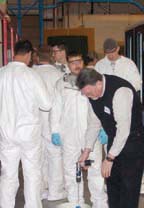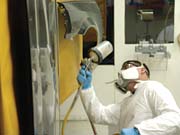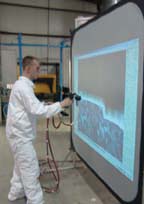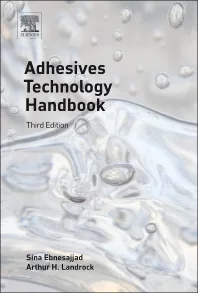Training and Technology Team Up

An important difference between efficient and inefficient paint operations often can be attributed to the availability of necessary training to become a skilled paint technician. The key to becoming a skilled technician is to master basic spray gun techniques. The correct techniques produce high quality finishes with a minimum of paint loss. Poor techniques waste paint, cause unnecessary cleanup problems, and fatigue the operator.
There are some important characteristics that a painter must have in order to master these techniques and become a skilled paint technician. First, paint technicians must have good motor skills, good hand-eye coordination and be able to consistently move their body while appropriately applying paint. A paint technician must also have an interest in learning in order to improve and be proud of the work produced. The final step in acquiring skilled paint technicians is in the hands of the business to provide an effective training program.

Components of Training
The ultimate goal of an effective painter training program should be to improve the application efficiency of the process. Application efficiency is a concept that consists of three basic components: finish quality, transfer efficiency (TE) and build efficiency (BE). It is important that a paint technician understand the relationship of these components. To effectively teach this relationship, a training program should include subject knowledge and hands-on demonstrations explaining how proper spray techniques can simplify the painting process. Most importantly, the painter needs to be given the opportunity to practice and experiment with proper spray techniques.TE is the amount of coating deposited on the part compared to the amount sprayed. Low TE occurs when a large percentage of the material being sprayed misses the target and is wasted as overspray. BE is a measure of how closely and consistently the paint applied to a part meets your target dry film thickness. If the film build applied to a part is too heavy or too light, finish quality objectives may not be met. Accurate film builds are important because less material consumption saves money and correlates to decreased air emissions as well as less spray booth maintenance, equipment wear and material handling.
The cumulative effect of poor TE and poor BE has a dramatic impact on material consumption and VOC emissions. Poor TE and BE numbers contribute to excessive production costs, higher air emissions, more maintenance and material handling, excessive hazardous and non-hazardous waste generation rates and a less than desirable employee work environment.
Finish quality is the most critical aspect of application efficiency. The best of TE and BE numbers are worthless if the finish quality doesn't meet requirements. An unacceptable finish means excessive production costs in terms of wasted time, material and energy, corresponding to higher waste disposal and maintenance costs. From an environmental perspective, poor finish quality correlates to excessive volatile organic compound (VOC) emissions and waste generation rates.

Traditional Painter Training
Many businesses do not provide their painters with an effective training program necessary to become skilled paint technicians. This is largely due to the amount of time, labor, space, material and ultimately the cost of conducting an effective hands-on training program. Traditionally, IWRC instructors would spend a full day conducting hands-on, in-booth training for only two or three painters. Extensive in-booth training was necessary for some painters to understand, practice and become proficient with proper spray gun techniques. As a result, the expense of training was increasing due to cost of materials, staff hours, hazardous waste, safety costs, equipment costs, etc. This also limited the number of painters that could be trained by the IWRC in a year. As the demand for IWRC training increased within the military, the IWRC was able to improve its training program through the incorporation of existing technologies as well as the development of new ones to help reduce the time, cost and space restraints of traditional training.
Improvements in New Training Technologies
Today, new technologies exist that have greatly reduced the limitations of traditional training. The training tools that have provided the greatest benefit to the IWRC training program are the Laser Touch targeting tool and the Virtual Reality Paint Simulator. These combined technologies help to efficiently and effectively train a painter in proper spray application methods, resulting in a significant increase in application efficiency.Developed by the IWRC, the Laser Touch targeting tool is mounted onto a spray gun to improve painting performance. The targeting device uses a two-dot laser to help maintain proper gun angle and gun-to-part distance. The laser beams can be adjusted to form a single dot when the spray gun is at the correct preset distance from the part. If the gun moves too far or too close, the beams separate. This tool enables the operator to paint and maintain the correct distance for consistent paint application. The single dot can be used to target the spray pattern on the part in a way that results in an accurate 50 percent overlap on the painting surface. Finally, if the painter strays from the proper spray distance or angle, two separate laser images will again appear, alerting the spray technician to the inconsistent spraying.
The most recent IWRC program advancement is the use of a computer-integrated Virtual Reality Paint Simulator (VR). VR technology has been successfully used in many training applications such as flight simulators. IWRC incorporation of this technology into its training programs has proved VR as an ideal accompaniment to "hands-on" painter training. Imagine the capability to train an individual to paint without ever having to wear a respirator, put on a paint suit, or even spray in a booth. These benefits, along with eliminating the need to mix paint and prepare the part, allow the painter to put a greater focus on spray gun setup and adjustments for the specific object being painted. Spray training with the VR system has many advantages because it eliminates solvent exposure, material waste, cleanup and the need for environmental air permitting. A painter can practice proper technique over and over again without generating any extra expense. An important characteristic of any VR paint training system is that it exaggerates improper technique. This exaggeration of poor technique makes it much easier for instructors and students to identify certain technique flaws.
A VR system uses computer hardware and software to simulate real-life situations. The hardware necessary to operate a VR system includes a real hand-held spray gun, motion tracking device and either a rear projection or head-mounted display. The software includes the VR spray painting program, which interacts with the hardware through a central computer system to simulate actual spray painting. When the spray gun is triggered, the tracking system detects the position of the spray gun and projects virtual paint onto a virtual object appearing on the display.
The virtual paint sprayed on the virtual object will appear in a three-color system. To simulate thin or dry spray, the paint will appear as a gradation from white to gray, and a red color will represent application of too much paint. The correct paint build will appear as a black color. The visual feedback provided by this color system allows painters to see areas where paint is too thin or too thick.
Another advantage to the VR system is that only one individual is needed to operate the system and instruct on painter technique at the same time. In addition, the VR system is capable of calculating data from the object being painted, which can be used by the student and the instructor to help improve technique. Important data that is recorded includes the percentage of the object where paint is applied too thick or too thin, percentage of the object with the correct amount of paint and the TE of virtual paint sprayed.
The flexibility provided by VR painter training equipment is a significant improvement over traditional training methods. However, hands-on in-booth spraying is still very important in the training process. The VR can be used as a complement to actual spraying, allowing painters a means to practice and perfect painting technique before they ever step foot in a real paint booth. This technology also will allow businesses the capability of testing the ability of an individual before they will be hired as a painter. Improvements continue to be made to this technology with the idea that many businesses will be able to utilize VR to develop a training program that will transition their painters into skilled paint technicians capable of producing consistent, quality work while minimizing process waste.
Jeremiah Treloar is a STAR4D program assistant and Kaylene Reilly is a public relations assistant at the Iowa Waste Reduction Center, Cedar Falls, Iowa. They can be reached at 319-273-8905 or visit www.iwrc.org. The Iowa Waste Reduction Center is a service of the University of Northern Iowa, providing free, confidential and non-regulatory environmental assistance to small businesses throughout Iowa. The goal at the IWRC is to enable businesses to reduce waste and implement pollution prevention practices that will help increase cost savings through the use of technologies, training and individual assistance. IWRC's expertise is also now available to military painting operations through the national STAR4Defense program.
Looking for a reprint of this article?
From high-res PDFs to custom plaques, order your copy today!






